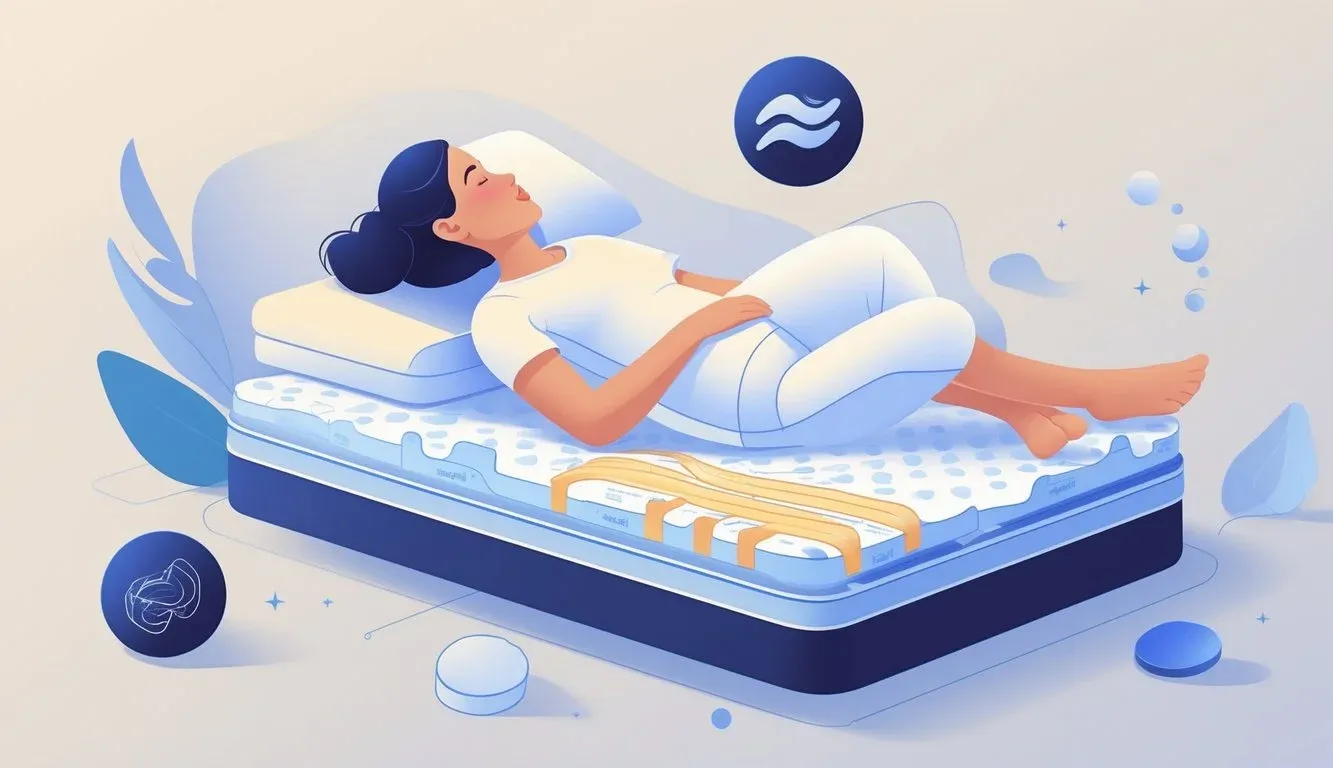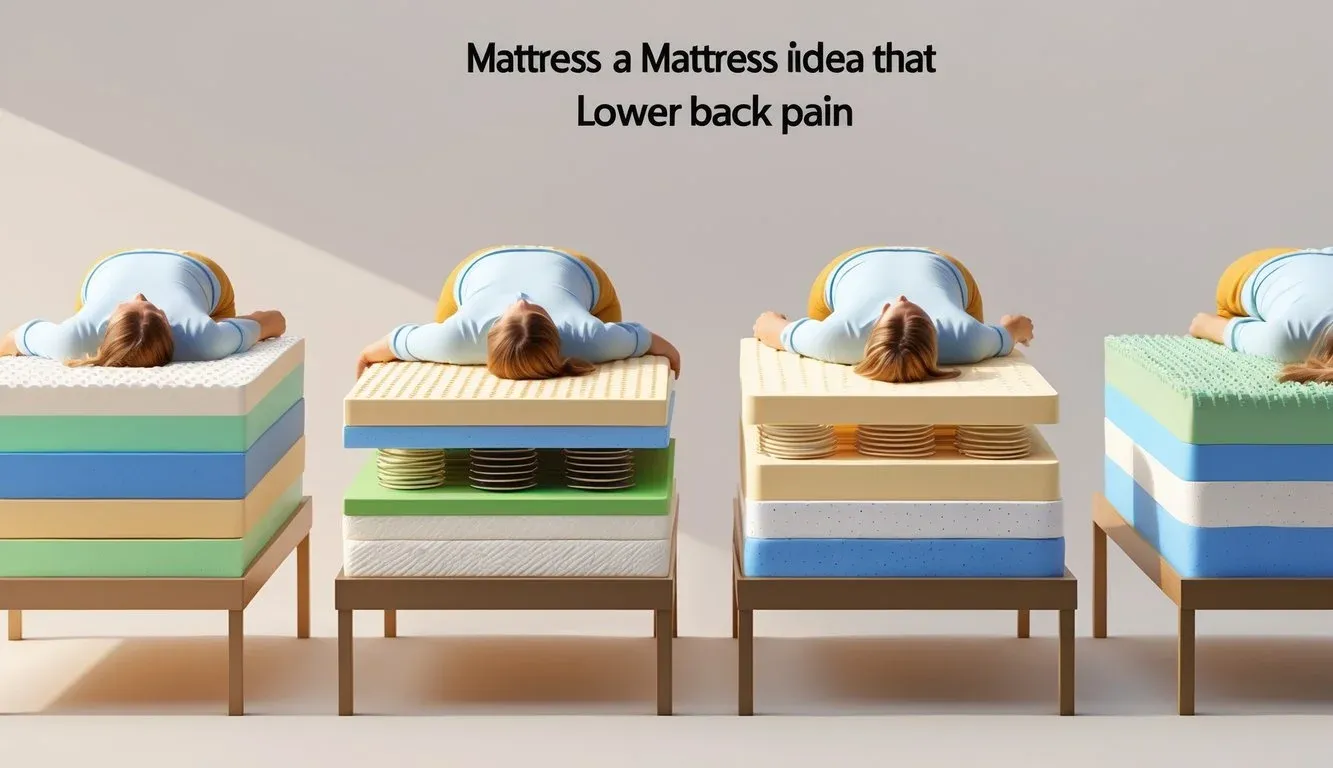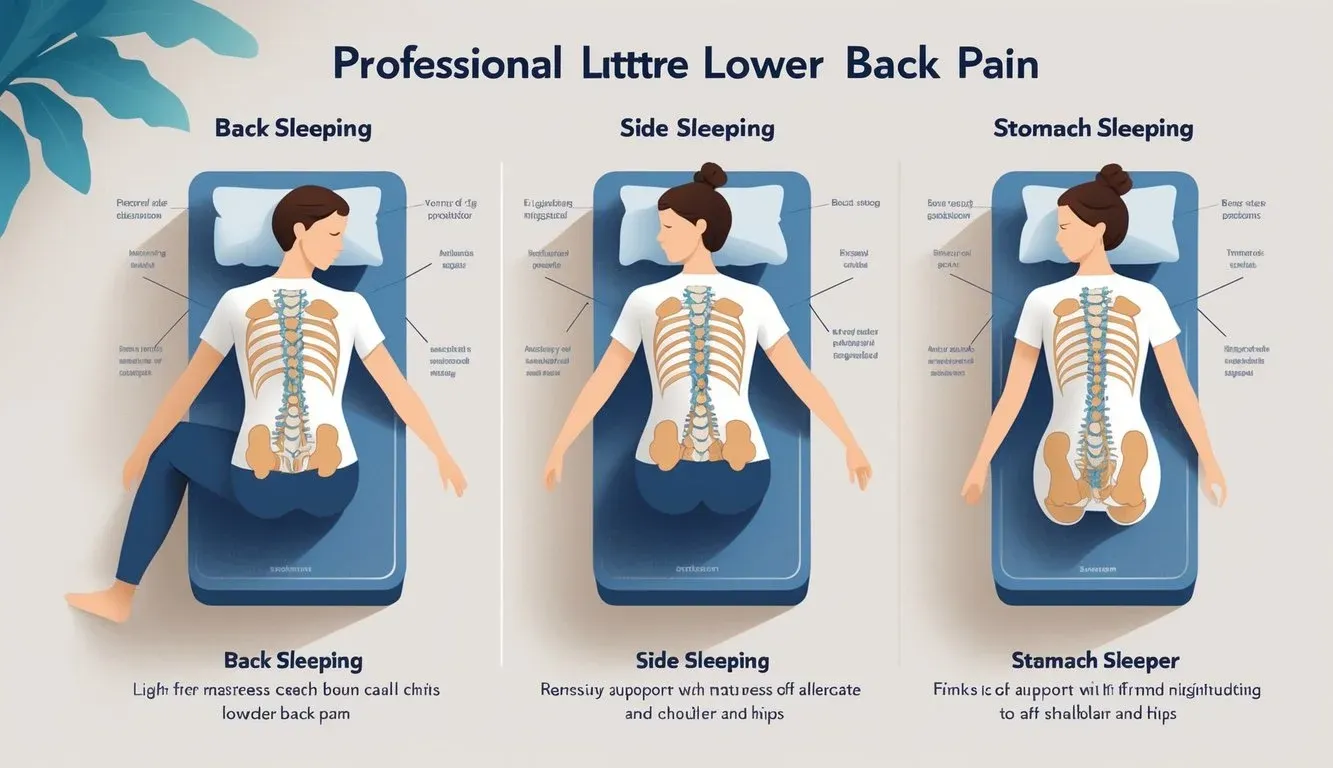The best type of mattress for lower back pain is usually a medium-firm mattress that gives support while also allowing for some cushioning. People with lower back pain often wake up feeling stiff or sore, and the wrong mattress can make these problems worse. A good mattress supports the natural curve of the spine and helps the muscles relax overnight.

Many doctors and sleep experts recommend medium-firm mattresses because they balance comfort and support. Softer mattresses may let the body sink too much, while very hard ones might not give enough pressure relief. Choosing the right mattress can make a real difference for people who struggle with lower back pain.
Understanding Lower Back Pain and Sleep

Lower back pain can make getting a full night’s rest difficult. Choosing the right mattress helps support the spine and can lessen discomfort.
How Mattress Selection Impacts Back Pain
A mattress that is too soft can let the body sink, making the spine curve unnaturally. This may increase back pain, especially in the lower back area. On the other hand, a very hard mattress might push against certain body parts and create pressure points.
Key features to look for in a mattress:
- Firmness: Medium-firm mattresses are often recommended for lower back pain.
- Support: The mattress should hold the spine in a straight line.
- Material: Memory foam and latex can provide good support and comfort.
Sleeping on a mattress not suited for individual needs can worsen back pain over time. Testing out mattresses in person or reading detailed reviews may help in finding a better fit.
The Role of Spinal Alignment During Sleep
Proper spinal alignment helps reduce strain on the lower back while sleeping. The mattress should support the body so the spine stays in a neutral position—from the neck to the tailbone.
Lying on the back or side with the right pillow and mattress height keeps the spine level. If the hips, shoulders, or lower back dip too much, this can cause misalignment.
Signs of poor spinal alignment during sleep may include:
- Waking up stiff or sore
- Feeling pain in the morning
- Having trouble finding a comfortable sleeping position
Good spinal alignment can make sleep more restful and lessen back pain over time.
Best Type of Mattress for Lower Back Pain – Key Features
Finding relief from lower back pain starts with picking a mattress offering the right firmness, support, and pressure relief. Key features like contouring and mattress durability can directly affect comfort and long-term spine health.
Optimal Firmness Level and Support
The best mattress for back pain usually has a medium-firm to firm feel. This level lets the mattress keep the spine straight during sleep. A mattress that’s too soft can let the hips and shoulders sink too far, causing misalignment.
Proper support is also important. Support comes not just from how hard or soft the surface feels, but also from materials like memory foam, latex, or pocketed coils. These materials help keep the lower back from arching or sagging during the night.
A simple chart can help:
| Firmness Level | Who It May Suit |
|---|---|
| Plush/Soft | Side sleepers without back pain |
| Medium-Firm | Most people with lower back pain |
| Firm | Back and stomach sleepers |
Choosing the right firmness level helps reduce pressure on sore muscles and prevents waking up with stiffness.
Pressure Relief and Contouring
Pressure relief is key because it stops sensitive areas from getting sore while the person sleeps. Mattresses with contouring features help by shaping to the curves of the body, especially the lower back and hips. This keeps weight spread out and stops pain points from forming.
Memory foam and some hybrid mattresses often give better pressure relief. Look for mattresses labeled with pressure-relieving features, including layers designed to ease pressure near the hips and lower back.
Contour support helps maintain spine alignment. A mattress that doesn’t offer this might make pain worse or last longer. Testing out different materials in-store or finding reviews about contouring performance can help with the choice.
Responsiveness and Durability
A responsive mattress makes it easy to move without sinking too deeply. Good responsiveness helps with turning over, making it simpler to find a comfortable sleep position. Latex and many innerspring mattresses often have better bounce, while high-density memory foam can be less responsive.
Durability matters because a worn-out mattress won’t support the back well. Materials like natural latex and quality coil systems tend to last longer.
Key signs of good durability include:
- High-density foam (at least 1.8 lbs/ft³)
- Thicker coil gauge (lower number equals stronger support)
- Warranty coverage of 8–10 years or more
Mattresses built with strong, lasting materials tend to give stable support and pressure relief over time.
Best Mattress Types for Lower Back Pain

Choosing the right mattress can help reduce lower back pain and support a healthy spine. The main mattress types—memory foam, hybrid, innerspring, and latex—each offer different benefits and features.
Memory Foam Benefits and Drawbacks
Memory foam mattresses are popular for pressure relief. They mold to the body, allowing the spine to stay in a natural position. This can reduce pain points in the lower back.
People who sleep on their side or back may find memory foam especially helpful. It can support the hips and shoulders, which are common problem areas for pain.
However, memory foam often traps heat, so those who sleep hot might feel uncomfortable. Some people also find it too soft or slow to respond when changing positions.
A quick overview:
| Pros | Cons |
|---|---|
| Good pressure relief | Can feel hot |
| Even weight support | May feel too soft |
| Spine alignment | Slow to bounce back |
Hybrid Mattress Advantages
A hybrid mattress mixes memory foam or latex with innerspring coils. This creates a balance between comfort and support. The foam layers cushion the body, while the coils provide extra firmness and keep the body lifted.
Many people with lower back pain like hybrid mattresses. The coils help keep the spine straight all night, and the foam gives pressure relief.
Unlike an all-foam bed, hybrids tend to sleep cooler because air can flow more easily through the coil layer. They also bounce back faster, making it easier to move around or get out of bed.
Hybrid mattresses often last longer than standard foam beds. They offer a good mix for people who want both support and comfort.
Innerspring and Latex Options
Innerspring mattresses have a core of metal coils with thin layers on top. They feel firm and offer strong support, which can help keep the spine aligned but may not always give enough cushioning for pressure points.
Latex mattresses use natural or synthetic rubber foam. They are known for being responsive and supportive without feeling too soft. Latex gives gentle support, and natural latex holds up well over time.
Latex mattresses are usually cooler than memory foam options. They resist sagging and can support the lower back effectively. However, they cost more than many other mattress types and may not feel soft enough for everyone.
People who prefer a firmer surface for back support often choose innerspring or latex styles. These mattresses can help with spinal alignment for those with lower back pain.
Choosing a Mattress Based on Sleeping Position

The right mattress depends on how a person sleeps. Sleeping position affects the amount of support and cushioning needed, especially for those with lower back pain.
Side Sleepers: Support and Cushioning
Side sleepers tend to put pressure on their shoulders and hips. A mattress that is too firm can push against these points and cause pain or numbness.
Medium and medium-soft mattresses help side sleepers by allowing the shoulders and hips to sink in just enough. This keeps the spine in a straight line and can prevent lower back pain. Memory foam and hybrid mattresses often provide this type of contouring and support.
Look for mattresses with zoned support or a cushioned top layer. These features add comfort where it’s needed most and can improve sleep quality. However, overly soft mattresses can let the body sink too deep, bending the spine and causing discomfort.
Here is a quick guide for side sleepers:
- Ideal firmness: Medium to medium-soft
- Mattress types: Memory foam, hybrid
- Must-have features: Pressure relief, cushioned top, zoned support
Back Sleepers: Balanced Comfort and Alignment
Back sleepers need a mattress that supports the natural curve of the lower back. Too-soft surfaces may let the hips drop, leading to stiffness or pain. Too-firm mattresses can push the spine out of alignment.
A medium-firm mattress is often best for back sleepers. It should hold up the hips and shoulders, but also give a slight cushion for comfort. Latex and dense foam mattresses usually fit this profile and keep the body from sinking in too far.
A key point for back sleepers is spinal alignment. Look for a mattress that keeps the spine level from head to base. Features like targeted support zones and extra lumbar support are helpful for this sleeping position. For extra comfort, some back sleepers prefer a firmer base with a thin, soft top layer.
Checklist for back sleepers:
- Ideal firmness: Medium-firm
- Mattress types: Latex, memory foam, hybrid
- Must-have features: Lumbar support, firm base
Special Considerations for Body Weight

Body weight affects how much support and comfort a mattress provides for people with lower back pain. Lighter and heavier sleepers may need different things from a mattress to get the best relief.
Lightweight vs. Heavyweight Sleepers
Lightweight sleepers (under 130 pounds) often do not press down into a mattress as much. If the mattress is too firm, it may not conform well to the natural curve of their back. This can lead to gaps under their lower back and poor support.
Heavyweight sleepers (over 230 pounds) usually need extra support to prevent sinking too deeply. If the mattress is too soft, their hips and shoulders can dip too far in, causing the spine to bend out of alignment. This can cause or worsen back pain.
Table: Mattress Types for Body Weight
| Body Weight | Recommended Mattress Type |
|---|---|
| Under 130 lbs | Medium-soft to medium |
| 130–230 lbs | Medium-firm |
| Over 230 lbs | Firm or extra firm |
Shoppers should look for a mattress that matches their body weight to avoid discomfort and help keep their spine in a straight line.
Adjusting Mattress Firmness for Optimal Support
Mattress firmness should match both body weight and sleeping position to lower back pain. A medium-firm mattress fits many people, but it is not the best for everyone.
Heavier people often do best with firmer beds because they prevent sagging and keep the hips and shoulders level. Lighter people may prefer softer beds for better pressure relief, especially in the lower back area.
If a mattress is too firm or too soft, a mattress topper can adjust how the surface feels. Toppers come in softer or firmer options to make small changes without buying a new mattress.
Proper firmness can prevent the spine from curving in unhealthy ways during the night. This helps reduce stress on the lower back and can help sleepers feel better in the morning.
Mattress Recommendations for Stomach Sleepers

Stomach sleepers need a mattress that keeps the spine flat and supported. A mattress that is too soft can cause the hips to sink, which may lead to lower back pain.
Medium-firm mattresses are often best for stomach sleepers. This firmness level helps keep the body in a neutral position.
Memory foam mattresses with a supportive core can work for some people. Look for ones that do not sink much under the stomach or hips.
Some stomach sleepers find that latex mattresses provide good support. Latex does not lose shape quickly and can keep the body lifted.
Here is a simple chart showing options:
| Mattress Type | Features |
|---|---|
| Innerspring | Good support, some firmness |
| Memory Foam | Pressure relief, must be medium-firm |
| Latex | Bouncy, keeps body on top of bed |
| Hybrid | Support from coils, some comfort foam |
Extra tips for stomach sleepers:
- Choose a thin or flat pillow to avoid neck strain.
- Test the mattress firmness in-store if possible.
- Rotate the mattress every few months.
Selecting the right mattress can reduce stress on the lower back and help stomach sleepers rest better.
Frequently Asked Questions

Mattress type, firmness, and materials all play a direct role in helping manage lower back pain. Experts and consumer reports help guide people toward choices that fit both their comfort and budgets.
What kind of mattress do chiropractors recommend for lower back pain?
Chiropractors often suggest a medium-firm mattress.
This type supports the spine, keeping it in a natural position, which can help reduce pain.
They may sometimes recommend memory foam or hybrid designs for their balance of comfort and support.
How does mattress firmness impact lower back pain relief?
Firmness can affect how the body rests during sleep.
A too-soft mattress lets hips and shoulders sink in too far, while a very firm mattress does not give enough for proper alignment.
Medium-firm mattresses usually keep the spine level without pressing on pressure points.
Can a medium firm mattress reduce symptoms of back pain and sciatica?
Medium-firm mattresses help keep body weight balanced and the lower back supported.
This level of firmness can help with both general back pain and sciatica because it supports proper alignment and minimizes pressure in the lower back area.
Many people with sciatica report less pain with a medium-firm sleep surface.
What materials in mattresses are best suited for people suffering from back pain?
Memory foam, latex, and hybrid mattresses are often preferred.
Memory foam offers support and relieves pressure. Latex is known for its gentle bounce and support.
Hybrids combine pocketed coils with foam for both structure and comfort.
Which mattresses do consumer reports suggest for alleviating lower back pain?
Consumer reports often highlight medium-firm foam or hybrid mattresses for back pain relief.
Brands like Tempur-Pedic, Saatva, and Sleep Number receive frequent positive reviews for support and comfort.
Testing different models in-store or looking for risk-free trial periods can also help in choosing the best mattress.
How can I select a budget-friendly mattress that also supports my lower back needs?
Look for brands that offer budget or value lines but still use high-density foams and supportive coils.
Read user reviews about back support and trial periods.
Mattresses sold online often offer lower prices and generous return policies, making it easier to find quality at a lower cost.